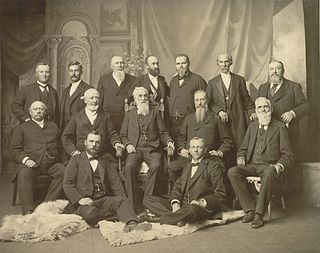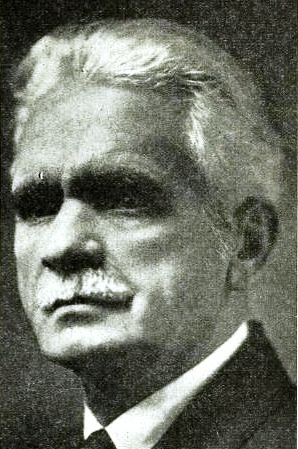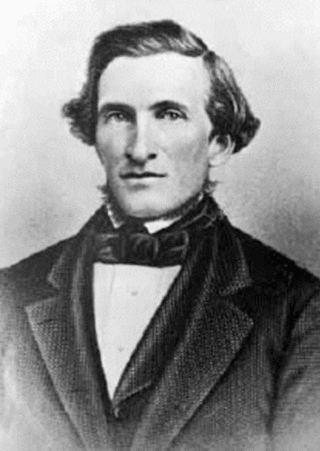History
Wikisource has original text related to this article:
The Journal was the proposal of George D. Watt, who was Brigham Young's stenographer. Watt had recorded several early sermons in Pitman shorthand, and proposed to the LDS Church that this and other material be published, with printing to be done in England where printing costs were cheaper. [1] The church's First Presidency immediately approved the idea, and officially granted Watt the privilege of preparing and publishing them. [1] Watt recorded the material in the first four volumes of sermons himself, and he continued to contribute through volume twelve, but at least eleven other stenographers were involved.
After recording the sermons, Watt transcribed them and sent them to the speaker for careful review. [3] By far, Young has the most sermons recorded in the Journal, with 390. It was said that:
Brigham Young secured stenographic reports of his addresses. As he traveled among the people, reporters accompanied him. All that he said was recorded. Practically all of these discourses (from December 16, 1851 to August 19, 1877) were published in the Journal of Discourses, which was widely distributed. The public utterances of few great historical figures have been so faithfully and fully preserved. [4]
For at least the first volume, Young personally edited his own sermons. [1] For future volumes, Young helped to select which sermons should be included in the publication, and he assigned his personal secretary to carefully copy-edit the manuscript pages before publication. [3]
Full title
The full title of the journal was inconsistent across volumes. The title of the first volume was, Journal of Discourses by Brigham Young, President of the Church of Jesus Christ of Latter-day Saints, His Two Counsellors, the Twelve Apostles, and Others. In volume 6, the title was shortened to Journal of Discourses by President Brigham Young, His Two Counsellors, the Twelve Apostles, and Others. In some of the first 19 volumes, the word "Delivered" was added to the title to precede the word "by". Some of these volumes omitted the words "and Others" and some replaced the phrase "His Two Counsellors" with "His Counselors".
Volume 20 was the first published after the death of Brigham Young, and the title used was Journal of Discourses by President John Taylor and Other Members of the Quorum of the Twelve Apostles. Also, Remarks by Other Prominent Elders. Volume 21—published after John Taylor had been ordained as Young's successor to the office of President of the Church—adopted the title Journal of Discourses by President John Taylor, His Counsellors, the Twelve Apostles, and Others, which remained consistent until the final 26th volume.
The Adam–God doctrine was a theological idea taught in mid-19th century Mormonism by Brigham Young, a president of the Church of Jesus Christ of Latter-day Saints. Although the doctrine is rejected by the LDS Church today, it is still an accepted part of the modern theology of some Mormon fundamentalists.

John Taylor was an English-born religious leader who served as the third president of the Church of Jesus Christ of Latter-day Saints from 1880 to 1887. He is the first and so far only president of the LDS Church to have been born outside the United States.

In the Church of Jesus Christ of Latter-day Saints, the Quorum of the Twelve Apostles is one of the governing bodies in the church hierarchy. Members of the Quorum of the Twelve Apostles are apostles, with the calling to be prophets, seers, and revelators, evangelical ambassadors, and special witnesses of Jesus Christ.
Within Mormonism, the priesthood authority to act in God's name was said by its founder, Joseph Smith, to have been removed from the primitive Christian church through a Great Apostasy, which Mormons believe occurred due to the deaths of the original apostles. Mormons maintain that this apostasy was prophesied of within the Bible to occur prior to the Second Coming of Jesus and was therefore in keeping with God's plan for mankind. Smith claimed that the priesthood authority was restored to him from angelic beings—John the Baptist and the apostles Peter, James, and John.
In orthodox Mormonism, the term God generally refers to the biblical God the Father, whom Latter Day Saints refer to as Elohim, and the term Godhead refers to a council of three distinct divine persons consisting of God the Father, Jesus Christ, and the Holy Ghost. However, in Latter Day Saint theology the term God may also refer to, in some contexts, the Godhead as a whole or to each member individually. Latter Day Saints believe that the Father, Son, and Holy Ghost are three distinct beings, and that the Father and Jesus have perfected, glorified, physical bodies, while the Holy Ghost is a spirit without a physical body. Latter Day Saints also believe that there are other gods and goddesses outside the Godhead, such as a Heavenly Mother—who is the wife of God the Father—and that faithful Latter-day Saints may attain godhood in the afterlife. The term Heavenly Parents is used to refer collectively to the divine partnership of Heavenly Father and a Heavenly Mother. Joseph Smith taught that God was once a man on another planet before being exalted to Godhood.

Brigham Henry Roberts was a historian, politician, and leader in the Church of Jesus Christ of Latter-day Saints. He edited the seven-volume History of the Church of Jesus Christ of Latter-day Saints and independently wrote the six-volume Comprehensive History of the Church of Jesus Christ of Latter-day Saints. Roberts also wrote Studies of the Book of Mormon—published posthumously—which discussed the validity of the Book of Mormon as an ancient record. Roberts was denied a seat as a member of United States Congress because of his practice of polygamy.

The Encyclopedia of Mormonism is a semi-official English-language encyclopedia for topics relevant to the Church of Jesus Christ of Latter-day Saints. The five-volume texts have been digitized and are available for free online via the Harold B. Lee Library's official website.
Thomas Baldwin Marsh was an early leader in the Latter-day Saint movement and an original member of the Quorum of the Twelve Apostles, who served as the quorum's first president in the Church of the Latter Day Saints from 1835 to 1838. He withdrew from the church in 1838, was excommunicated from it in 1839, and remained disaffected for almost 19 years. Marsh was rebaptized into the Church of Jesus Christ of Latter-day Saints in July 1857, but never again served in church leadership positions.

Blood atonement is a disputed doctrine in the history of Mormonism, under which the atonement of Jesus does not redeem an eternal sin. To atone for an eternal sin, the sinner should be killed in a way that allows his blood to be shed upon the ground as a sacrificial offering, so he does not become a son of perdition. The largest Mormon denomination, The Church of Jesus Christ of Latter-day Saints, has denied the validity of the doctrine since 1889 with early church leaders referring to it as a "fiction" and later church leaders referring to it as a "theoretical principle" that had never been implemented in the LDS Church.

Jedediah Morgan Grant was a leader and an apostle of the Church of Jesus Christ of Latter-day Saints. He was member of the First Council of the Seventy from 1845 to 1854 and served in the First Presidency under church president Brigham Young from 1854 to 1856. He is known for his fiery speeches during the Reformation of 1856, earning the nickname "Brigham's Sledgehammer". Grant is the father of Heber J. Grant, who later served as President of the Church.
The Mormon Reformation was a period of renewed emphasis on spirituality within the Church of Jesus Christ of Latter-day Saints, and a centrally-directed movement, which called for a spiritual reawakening among church members. It took place during 1856 and 1857 and was under the direction of church president Brigham Young. During the Reformation, Young sent his counselor, Jedediah M. Grant, and other church leaders to preach to the people throughout Utah Territory and surrounding Latter-day Saint communities with the goal of inspiring them to reject sin and turn towards spiritual things. During this time, some of the most conservative or reactionary elements of LDS Church doctrine came to dominate public discussion. As part of the Reformation, almost all "active" or involved LDS Church members were rebaptized as a symbol of their commitment. The Reformation is considered in three phases: a structural reform phase, a phase of intense demand for a demonstration of spiritual reform, and a final phase during which an emphasis was placed on love and reconstruction.
The Church of Jesus Christ of Latter-day Saints teaches that Adam and Eve were the first man and the first woman to live on the earth and that their fall was an essential step in the plan of salvation. Adam in particular is a central figure in Mormon cosmology. Robert L. Millet, a Latter-day Saint author, wrote of the church's perspective:
Few persons in all eternity have been more directly involved in the plan of salvation—the creation, the fall, and the ultimate redemption of the children of God—than the man Adam. His ministry among the sons and daughters of earth stretches from the distant past of premortality to the distant future of resurrection, judgment, and beyond.
In the Latter Day Saint movement, the Quorum of the Twelve is one of the governing bodies or (quorums) of the church hierarchy organized by the movement's founder Joseph Smith and patterned after the Apostles of Jesus. Members are called Apostles, with a special calling to be evangelistic ambassadors to the world.

George Darling Watt was the first convert to Mormonism baptized in the British Isles. As a member of the Church of Jesus Christ of Latter-day Saints, Watt was a secretary to Brigham Young, the primary editor of the Journal of Discourses, and the primary inventor of the Deseret Alphabet.

Mormon cosmology is the description of the history, evolution, and destiny of the physical and metaphysical universe according to Mormonism, which includes the doctrines taught by leaders and theologians of the Church of Jesus Christ of Latter-day Saints, Mormon fundamentalism, the Restoration Church of Jesus Christ, and other Brighamite denominations within the Latter Day Saint movement. Mormon cosmology draws from Biblical cosmology, but has many unique elements provided by movement founder Joseph Smith. These views are not generally shared by adherents of other Latter Day Saint movement denominations who do not self-identify as "Mormons", such as the Community of Christ.
Mormons have both used and been subjected to significant violence throughout much of the religion's history. In the early history of the United States, violence was used as a form of control. Mormons were violently persecuted and pushed from Ohio to Missouri, from Missouri to Illinois and from Illinois, they were pushed west to the Utah Territory. There were incidents of massacre, home burning and pillaging, followed by the death of their prophet, Joseph Smith. Smith died from multiple gunshot wounds from a lynch mob at a jail in Carthage, Illinois; Smith had defended himself with a small pistol smuggled to him by church leader Cyrus Wheelock and he was then shot while trying to flee from a window. There were also notable incidents in which Mormons perpetrated violence. Under the direction of Mormon prophets and apostles, the Mormon burned and looted Davies County, attacked and killed a member of the Missouri state militia, and carried out an extermination order on the Timpanogos. Other Mormon leaders led the Mountain Meadows Massacre, Battle Creek massacre, and Circleville Massacre. Mormons have also been a major part in several wars, including the 1838 Mormon War, Walker War and Black Hawk War.
Bible Dictionary is an official publication of the Church of Jesus Christ of Latter-day Saints. Since 1979, Bible Dictionary has been published as an appendix to most copies of the King James Version (KJV) of the Bible printed by the LDS Church. The dictionary contains 1285 entries on 196 pages. The publication states that it was "designed to provide teachers and students with a concise collection of definitions and explanations of items that are mentioned in or are otherwise associated with the Bible."
The Mountain Meadows Massacre was caused in part by events relating to the Utah War, an armed confrontation in Utah Territory between the United States Army and Mormon Settlers. In the summer of 1857, however, Mormons experienced a wave of war hysteria, expecting an all-out invasion of apocalyptic significance. From July to September 1857, Mormon leaders prepared Mormons for a seven-year siege predicted by Brigham Young. Mormons were to stockpile grain, and were prevented from selling grain to emigrants for use as cattle feed. As far-off Mormon colonies retreated, Parowan and Cedar City became isolated and vulnerable outposts. Brigham Young sought to enlist the help of Indian tribes in fighting the "Americans", encouraging them to steal cattle from emigrant trains, and to join Mormons in fighting the approaching army.
Mormon theology has long been thought to be one of the causes of the Mountain Meadows Massacre. The victims of the massacre, known as the Baker–Fancher party, were passing through the Utah Territory to California in 1857. For the decade prior the emigrants' arrival, Utah Territory had existed as a theocracy led by Brigham Young. As part of Young's vision of a pre-millennial "Kingdom of God", Young established colonies along the California and Old Spanish Trails, where Mormon officials governed as leaders of church, state, and military. Two of the southernmost establishments were Parowan and Cedar City, led respectively by Stake Presidents William H. Dame and Isaac C. Haight. Haight and Dame were, in addition, the senior regional military leaders of the Mormon militia. During the period just before the massacre, known as the Mormon Reformation, Mormon teachings were dramatic and strident. The religion had undergone a period of intense persecution in the American mid-west.






